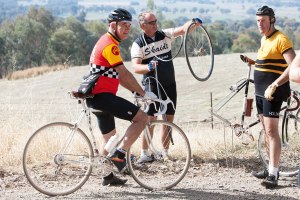Iain Treloar finds that there are people bringing bikes of the past back to their former glory—regardless of the vintage.
For all the thirst for new and high-tech advancements in bike riding, there’s an equal thirst for the nostalgic. When it comes to bikes, many admire the exploits (and rides) of the greats from the ’50s and ‘60s. They’re fascinated by the evolution of mountain bikes and intrigued by how the penny farthing has morphed into the lightweight, efficient machines of today.
Around the world, private collectors and museums have built amazing assortments of vintage bicycles. Some are broad in scope and others very specific. Perhaps one of the most impressive bike collections in the world belongs to Pryor Dodge, an American man who has amassed more than 2,000 artifacts, tracing the bicycle’s evolution over a century from 1817. Alongside relatively familiar sights like the penny farthing are rare pieces such as an immaculately carved wooden tricycle, constructed in France in the 1860s.
Advances in technology from the early years mean bicycles follow a fairly straightforward format nowadays—chain driven, inflatable tyred and two wheeled.
Take a glimpse back into the annals of history and you see this wasn’t always the case. Dodge’s collection shows a remarkable lack of convergence—designs were much different not only from modern bikes, but from each other as well. Alongside odd-wheeled contraptions with elaborate drive systems are ladies bikes that bear passing resemblance to modern ‘vintage’ bikes—with one notable exception. The pneumatic tyre hadn’t yet made its way onto bikes, so the visually conventional bikes pictured below rolled on a solid tyre. (Dodge’s collection is based in the United States, and has occasionally toured abroad; beautifully photographed selections can be viewed online at bicyclearts.com)
Closer to home, the Farren Collection in Melbourne features a broad assortment of vintage bicycles, cataloguing the diversity of the bike with an Australian twist. In amongst the European-origin hobby horses and pre-1910 oddities are traces of the domestic evolution of the bicycle, such as a 1928 Malvern Star three-seat tandem. Compiled by Paul and Charlie Farren, the collection houses roughly 85% of the pre-1900 bikes found in Australia. The scope of the collection is impressive; it includes a number of late 19th century bamboo bikes, at one point included every model by Malvern Star ever produced and has bikes dating back as far as 1869. (The Farren Collection is profiled in the book Bicycling Through Time, which can be purchased at imagespublishing.com).
While these bikes are steeped in bicycle history, a new type of collector—the fan, rather than the historian—is emerging. Relatively modern bikes are being added to stockpiles, changing hands for huge amounts of money. Take, for instance, the bikes once ridden by the late, great Italian climber Marco Pantani. Despite his legacy being tarnished by drug use, his explosive riding and unparalleled climbing prowess makes him one of the most revered riders in cycling history—and his bikes very valuable. Immaculately reconditioned bikes ridden by Pantani to his most famous victories now sell to collectors for extraordinary sums—a 2012 auction in Italy attracted over a hundred fans, with one of Pantani’s 1998 Bianchis selling for 13,000 Euro.
Bikes like these have special significance because of the rider associated with them, but period-correct older road bikes without a link to such famous exploits can also

have their day in the sun at vintage-themed road events, such as l’Eroica in Tuscany, or its Beechworth equivalent. Riders in these events wind through vineyards along white gravel roads (strada bianche) on pre 1987 bikes; no clipless pedals, minimal carbon fibre, and a dress-code of wool jerseys and string gloves. It’s a glimpse back into the past, with Molteni kits and downtube shifters combining to create a sepia-tinted day of fun in the saddle. To add to the experience of the Italian event, bicycle part swap-meets enable attendees to mingle and sniff out lusted-after Campagnolo componentry from the past. The 2014 edition of our local counterpart in Beechworth is held in March—for more details, visit www.granfondobeechworth.com.au.
On a slightly humbler—but no less impressive—scale are the individuals who restore the bikes of their youth, in doing so finding a way to relive their halcyon days. Arran Thorburn, an expat New Zealander living in Melbourne, focuses on the restoration of vintage mountain bikes from the 1980s and 90s. “My collection ‘target zone’ is ’89-’92, largely because that was the time in my life when I was dedicated wholly and solely to all things mountain bike… I have great memories of that time,” he explains. His collection has at times swelled to as many as 20 bikes, but today consists of a dozen carefully restored older bikes, as well as a few modern ones that he does the bulk of his riding on. “Unlike the majority of my fellow collectors, I don’t collect vintage mountain bikes because I like the way they ride. I consider my vintage bikes to be my own personal art collection,” Thorburn says.
It is predominantly nostalgia that drives Thorburn’s restorations—as a mountain-bike obsessed teenager on the South Island of New Zealand, there were many top-end bikes he lusted after but was unable to afford at the time. “After I contracted the VRC (Vintage, Retro, Classic) bug in 2006, I went to great lengths to secure two

particular bikes,” Thorburn says. “My 1992 Mantis XCR-EC holds special significance for me, because of the lengths I had to go to procure it and complete the build. I was contacted by a really nice older gent in the States, who was keen to pass his bike on to someone who would appreciate it as the classic piece of mountain bike history it was. Unfortunately, the shipping costs to Australia were too high, and I had to bow out of negotiations,” Thorburn explains. The bike was traded a couple of times, before “six years and three owners after my first attempt to buy it, I finally purchased the frame & fork, had it shipped to New Zealand, collected it during a trip and brought it home to Melbourne. I took my time with the Mantis build, making sure all components were ‘period-correct’, in new or as-new condition and of the highest quality. The build took around six months but in the context of the whole process it was the blink of an eye!”
The other jewel in Thorburn’s collection is a 1990 Nishiki Alien ACX. “To my amazement, after using the internet to scour the world for this bike, I was put in touch with a bike shop in Los Angeles that had a brand new 16″ Alien ACX in stock. Apparently, the store owner could never bring himself to discount a bike and consequently, this bike had sat there in his shop, unused, for 17 years!” After purchasing the bike and shipping it down under, the Nishiki is still unridden and immaculate: “in VRC parlance, it’s what’s known as a ‘Garage Queen’.”
A popular forum for the vintage bike restorer, and one of Thorburn’s regular haunts, is the UK-based RetroBike (retrobike.co.uk), which attracts thousands of avid members from around the world. Dedicated to the restoration of “retro, vintage and classic mountain, road and BMX bikes”, there aren’t a lot of niches left unfulfilled. Page after page of the forum details the exhaustive lengths that forum members go to in restoring bikes of the past to their former glory, with a thriving marketplace of NOS (New Old Stock) and used componentry. Users base their restorations on magazine pictures or catalogues from decades past, ensuring that every detail is correct all the way from stem colour down to cable-routing. With some of these bikes, it’s easy as an outsider to understand the impulse—there’s a tangible beauty to Klein’s road bikes of the 1990s, for instance—but other bikes on the website can be a little less immediate in their appeal. In the RetroBike forums, elegant road bikes rub shoulders with painstakingly restored low-end Giant mountain bikes from the late ‘80s, outdated steeds without high-end pedigree or any particular historical significance today—the reverence with which the bikes are treated is the same as if they were housed in an historical collection.
For collectors of those museum-worthy pieces of the 1800s and more modern bikes alike, the constant is an abiding, almost obsessive, appreciation for the form and function of the bicycle. From garage to gallery, the love story of bikes of the past continues to be written, one pre-loved gem at a time.
Ride On content is editorially independent, but is supported financially by members of Bicycle Network. If you enjoy our articles and want to support the future publication of high-quality content, please consider helping out by becoming a member.




Reblogged this on 2 Tyred 4 Fun and commented:
I love the passion that comes with bicycle riding. Non-cyclists just don’t seem to get it; but that’s O.K.
I am feeling pretty ok about my 1990s ProFlex which is still in use! Loving it.
Great to see this article.
The author neglected to mention our Queensland version of L’Eroica;
The NOOSA STRADE BIANCHE!
We are in our 4th year (I believe Beechworth has been cancelled this year).
http://www.noosa-stradebianche.com.au/
It’s August 9-10 2014; there is also a ‘Show and Shine’ for vintage bikes.
I have a great condition original nishiki alien acx rich Cunningham design. I’ve just been storing it for years. Any idea the value or where I might find a buyer?
Hi Jeremy, sorry for the slow response. Have a look on the forums on http://www.retrobike.co.uk for an idea of value or to sell, I’m sure there’ll be some interested parties.
Hi Jeremy, do you still have the alien? I may be interested. [email protected]